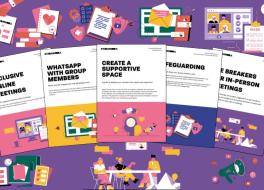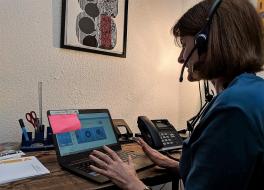Tips, workshops and training for making your calls accessible for people who stammer, or who have other speech differences.
If you are any of the following, this page is for you:
- A call centre.
- A helpline service.
- A customer service line.
- A small organisation with one or two staff taking calls.
- Someone who speaks to customers or service users over the phone in your role.
On this page, you'll find resources for businesses and for people who work on the phone. There's a report, a downloadable guide and free online workshops, all to help you make your calls accessible for people who stammer.
*Join one of our free online workshops
Silence on the phone?
Our report on phone call accessibility, which you can download below, outlines the experiences of 356 people who stammer when contacting businesses and organisations by phone. Topping the list of places contacted were financial services, insurance companies, health and social care, retail and consumer services.
98% of respondents told us that calling a business was hard. Most dread using the phone and expect to be cut off. And many were. Some were laughed at. Some had their stammering misinterpreted as nervousness. Some got stuck in voice response systems that didn't give them enough time to talk. Others just gave up trying.
Yet, many people who stammer do want to talk to you on the phone. Speaking to someone in a live phone conversation is often the most effective way to sort out an issue or resolve a query.
So, how do you tell if it's a bad phone signal or someone getting stuck on their words?
Follow the tips below and get details of our free online workshops and bespoke guidance or training. If you get stuck, just ring us. We're here to help.
"I was put through to a voice-activated automated menu immediately, so no opportunity to say I stammered. This resulted in me repeating a 14-digit tracking number literally about 10 times as the automated service could not understand it due to my stammer. The more times I had to repeat, the more frustrated and anxious I became. I ended up in tears with the frustration I felt."
"I block when I stammer so people I call think I'm at the end of my sentence when I'm struggling to get my next word out."
"I struggle with my name as I cannot navigate around it… I felt she thought I was stupid."

Good practice
Here are the three main areas that can cause difficulties and with tips below for dealing with them.
- How you respond at the start of calls.
- How you take callers through ID procedures.
- How your technology supports callers or creates barriers.
The start of calls
It's common for people who stammer to find they can't speak immediately when calls begin. They may experience a 'block', where no sound comes out of their mouth for several seconds or longer. Or you might hear sounds but not words as they're trying to speak.
It can be easy to assume that it's a bad line and then repeatedly ask if callers are there or hang up on them. This can be frustrating and humiliating for your caller.
Download our 'Silence on the line' guide below to see two suggested scripts for dealing with silence at the start of calls, or situations where you think there may be a bad line. These approaches create space for callers who stammer to speak, and a more supportive way to end calls when necessary.
ID processes
It's common for people who stammer to stammer on their own name or when saying key details. These are all words that can't be changed or said in a different way that's easier for people. Which means that ID procedures can be fundamentally difficult for people who stammer.
Don't assume that someone is nervous, unsure or fraudulent if they're having difficulty saying their name or account number. And don't say, "Did you forget your name?". That's not helpful.
Allow the caller the time they need to get their words out. Some people who stammer may choose to spell their name for you. That's OK.
If your system allows for information to be given verbally or by pressing keys on the number pad, offer all callers the option to choose between either of those channels.
Remember, it's normal for people who stammer to find those key words difficult to say. Give us time.
Technology
Look at customer record flagging, IVR and fraud detection.
Customer record flagging
Offer all of your customers the option to flag if they have extra needs when using the phone. Some customers may then choose to let you know that they stammer and request that it's added to their customer records. It's up to them.
Where flagged information is included on the customer, make sure it's available to agents as early as possible during the call.
IVR systems
If you have IVR in place, then check the following:
- What are the talk-time limits for callers? Is it long enough for callers who stammer to complete responses?
- What is your IVR system's word error rate for stammered speech versus fluent speech? Is it compatible?
- Is there an early escape route in your IVR system that allows callers with speech disabilities to speak to a human agent without being trapped in multiple loops of the IVR system first?
Fraud detection
Finally, if you have fraud procedures that use speech disfluency as a marker for potential fraud, this discriminates against people who stammer because their speech naturally contains disfluencies. So you risk wrongly suspecting people who stammer of deception.
our free online workshops
Over the next year, our free online Zoom workshops outline steps you can take to end the phone call nightmares for people who stammer. Join one and get familiar with aspects of stammering so that people in your organisation can feel more comfortable taking calls.
Workshops last 60 minutes, with 30 minutes of planned content and a further 30 minutes for anyone wanting to stay on for questions and discussion. Click on the dates below to book your place.
| Date | Time | Duration |
|---|---|---|
| Tuesday 25th November | 1pm | 1 hr |
| Tuesday 2nd December | 7pm | 1 hr |
| Thursday 11th December | 11am | 1 hr |
| Wednesday 7th January 2026 | 2pm | 1 hr |
| Monday 12th January | 1pm | 1 hr |
| Thursday 5th February | 7pm | 1 hr |
| Tuesday 10th February | 10am | 1 hr |
| Tuesday 17th March | 3pm | 1 hr |
| Monday 23rd March | 11am | 1 hr |
| Wednesday 22nd April | 7pm | 1 hr |
| Thursday 30th April | 9am | 1 hr |
| Tuesday 5th May | 4pm | 1 hr |
| Friday 15th May | 12pm | 1 hr |
| Monday 8th June | 7pm | 1 hr |
| Wednesday 17th June | 10am | 1 hr |
| Thursday 9th July | 2pm | 1 hr |
| Tuesday 21st July | 9am | 1 hr |
| Wednesday 5th August | 2pm | 1 hr |
| Tuesday 15th September | 7pm | 1 hr |
| Monday 21st September | 3pm | 1 hr |
| Friday 2nd October | 11am | 1 hr |
| Thursday 8th October | 12pm | 1 hr |
Contact us for bespoke guidance or training
We're happy to schedule a bespoke training session for your organisation or department. Contact us at training@stamma.org or call our free helpline on 0808 802 0002 and request a callback from our training team.



































